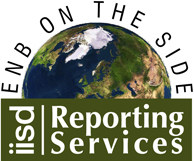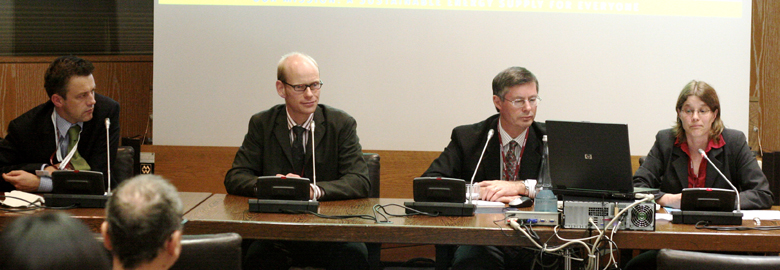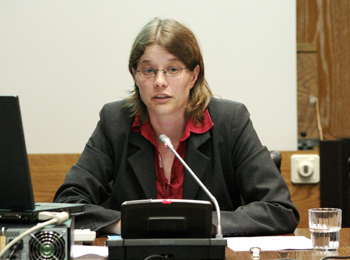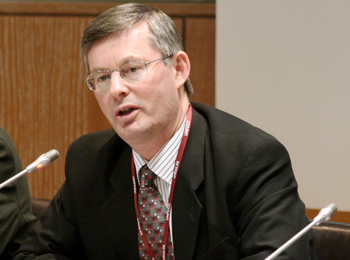 |
||
|
Published by the International Institute for Sustainable Development (IISD)
|
|||
|
A Special Report on Selected Side Events at the twenty-sixth sessions of the Subsidiary Bodies (SB 26) of the United Nations Framework Convention on Climate Change (UNFCCC)
|
|||||
| 7-18 May 2007 | Bonn, Germany | |||||
 |
|||
 |
|||
Events convened on Thursday, 17 May 2007
|
Sectoral Proposal Template: Putting a sectoral approach for developing countries into practice Presented by the European Business Council for Sustainable Energy (e5) |
|||
|
Niklas Höhne, Ecofys, said that e5 is a business focused initiative that advocates the full potential of sustainable energy in the EU and policy frameworks that establish a level playing field for producers of sustainable energy.
Murray Ward, GtripleC, presented “Sectoral Proposal Templates,” which aim to support developing countries in proposing sectoral emission baselines under a post-Kyoto climate regime. He said this approach focuses on scaling-up investments in clean technology and systems in developing countries. He explained that GtripleC and Ecofys are currently developing templates for the electricity, cement and transportation sectors, with the goal of performing a reality check by ‘road testing’ them in Mexico, Argentina, Chile and Peru. He noted that these templates are useful for systematically organizing all the elements relevant to a reasonable crediting baseline for a sector in a given country. Martina Jung, Ecofys, outlined the quantitative and qualitative elements of the cement template. She said the template includes background information on the country, past and present situation of the cement sector, sector-specific policies, and scenario assumptions and results. Jung described the emission reduction options in the cement template, which includes clinker adaptation, efficiency improvements, fuel switching, reduction in electricity use and blending. She said further steps include gathering comments on the cement template, developing electricity and transport templates, and “road testing” the templates. Martin Hession, Department for Environment, Food and Rural Affairs (DEFRA), UK, noted the UK’s commitment to the carbon market. He said the existing framework needs to continue and be further developed, and underscored the importance of the sectoral approach for CDM projects. He noted the Sectoral Proposal Templates are very detailed and noted his interest in the pragmatic results of the road testing and the possibility of scaling up the efforts. |
|||
|
|||
|
Implications of climate change for water Presented by the European Community (EC) |
|||
|
Merylyn McKenzie Hedger, European Environment Agency (EEA), outlined issues to tackle with regard to climate change and water, emphasizing water as a cross-sectoral adaptation issue. She said experience with recent events such as river flooding can inform adaptation measures, and highlighted the vulnerable regions and sectors. Hedger gave an overview of EEA work, noted the national initiatives that have arisen out of recent droughts, and emphasized the need to: embed climate change into all sectors; undertake synergistic actions at all levels; improve the communication of risks; involve civil society; climate-proof existing policy tools; and align mitigation and adaptation policy.
Mark Dowell, Institute for Environment & Sustainability, outlined Marine and Coastal Dimensions of Climate Change in Europe. He discussed, e.g., sea-level trends, changes in water characteristics, and the uncertainty involved. He said uncertainty drives the need for monitoring and technology development, improved Regional Climate Models, and research into, e.g., ocean acidification and sediment transport. He presented other conclusions of the report, including the need for systematic reporting on climate issues, and said the report suggests, inter alia: the full implementation of current policies; new directives; and R&D. Elisabeth Lipiatou, EC, discussed European climate change research, and said understanding the complex interactions is crucial in informing effective adaptation measures. Noting the need for international research cooperation, she discussed the policy context. Focusing on the 7th Framework Programme for Research and Technology Development (FP7), she outlined: the environmental research needs; results of past research; and specific projects and workshops relevant to water, extreme weather events and climate change. She highlighted the emphasis on: climate change impacts on atmosphere and water cycles; downscaling of models; the natural and socioeconomic impacts of climate change; and mitigation and adaptation. Marieke Van Nood, EC, presented the EU Water Framework Directive, the Floods Directive, and the Marine Strategy. She outlined the process of flood risk assessment and management, and said a Communication being drafted on scarcity and droughts will focus on water demand management, ineffective water pricing policies, inadequate water allocation, and the integration of water concerns into sectoral policies. Emphasizing the importance of sustainable water management in adaptation, she noted the challenges of: involving all water dependent sectors; pricing water; and implementing the “polluter pays” principle. Participants discussed, inter alia: the lessons learned from implementation of European water policies; the challenge of integrating water management into other sectors; and river basin district management. |
|||
|
|||
|
Global roundtable on climate change Presented by Columbia University |
|||
|
David Downie, Columbia University, said the global roundtable on climate change aims to provide a forum for discussion, analysis and exchange of ideas among businesses from all economic sectors and all parts of the world, including international institutions, NGOs and leading academic experts. He questioned how to meet the world’s energy needs without destabilizing the climate. Downie outlined the roundtable’s outputs, including a joint statement on the need to move towards a low-carbon economy, and demonstration projects and task forces on carbon sequestration.
Utz Tillmann, BASF, noted BASF has a voluntary target to reduce GHG emissions by 38%, relative to a 1990 baseline, and has set the goal to reduce specific GHG emissions per ton of sales products. He noted BASF’s strategy on energy efficiency and reducing GHG emissions is based on energy efficient processes and products, and on state-of-the-art energy generation with combined heat and power plants. Tillmann noted energy savings in the housing and fuel sectors, and BASF’s technologies’ contribution to lowering carbon dioxide emissions. He suggested that post-2012 commitments should include all major emitters. Ignacio Campino, Deutsche Telekom, outlined Deutsche Telekom experiences in reducing carbon dioxide emissions from both direct and indirect sources. He explained the company’s target to reduce GHG emissions by 50%, relative to a 1995 baseline, by 2010, and its aim to decouple energy consumption from carbon dioxide emissions. Highlighting that new services are increasing the company’s energy consumption, Campino noted his company’s activities on Strategic Energy Procurement, purchase of Renewable Energy Certificates, and a pilot project on fuel cells. Sabine Klages-Bluechner, DuPont, outlined DuPont’s mission, vision and values. She noted the company applies the same standards worldwide, and highlighted DuPont’s increased R&D productivity. She said DuPont’s target to reduce GHG emissions by 40%, relative to a 1990 baseline, by 2000, was achieved ahead of time. She stressed the new goal set in 1999 to reduce emissions by 65%, relative to a 1990 baseline, by 2010. She also noted her company has sustainability goals to reduce DuPont’s footprint regarding water conservation, car fleet fuel efficiency and air carcinogens. Klages-Bluechner suggested encouraging voluntary action, coordinating climate and energy policy, relying on market mechanisms, and engaging in discussions on genetically-modified organisms. Pablo Fernandez Guillen, Endesa, explained Endesa is a global electricity and gas company. He noted Endesa’s climate change strategy, managing GHG emissions under the EU Emissions Trading System through energy efficiency measures, promotion of CDM/JI projects, trade of EU allowances, and participation in a variety of Carbon Funds. He summarized the Endesa Climate Initiative and outlined planned measures to reduce emissions post-2012. |
|||
|
|||
|
||
|
Click the above button to go back to our ENB main coverage
|
||
|
|
|
|
|
||
|






